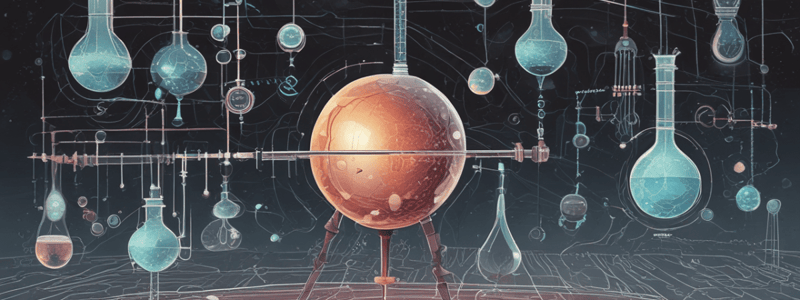Podcast
Questions and Answers
What is the relationship between pressure and volume according to Boyle's Law?
What is the relationship between pressure and volume according to Boyle's Law?
- Exponentially proportional
- Inversely proportional (correct)
- Directly proportional
- Logarithmically proportional
What is the unit of temperature that must be used in the combined gas law?
What is the unit of temperature that must be used in the combined gas law?
- Rankine
- Kelvin (correct)
- Fahrenheit
- Celsius
What is the significance of the number 22.4 in Avogadro's Law?
What is the significance of the number 22.4 in Avogadro's Law?
- It is the volume of a mole in liters (correct)
- It is the number of molecules in a mole
- It is the temperature at which the law is applicable
- It is the ratio of molecules to volume
What is the main difference between Charles' Law and Gay-Lussac's Law?
What is the main difference between Charles' Law and Gay-Lussac's Law?
What is the main idea behind Avogadro's Law?
What is the main idea behind Avogadro's Law?
What is the purpose of the combined gas law?
What is the purpose of the combined gas law?
What is the significance of the ratio of volumes in Gay-Lussac's Law of Combining Volumes?
What is the significance of the ratio of volumes in Gay-Lussac's Law of Combining Volumes?
What is the relationship between the volume of a gas and its temperature according to Charles' Law?
What is the relationship between the volume of a gas and its temperature according to Charles' Law?
What is the main difference between the particles in a solid and a liquid?
What is the main difference between the particles in a solid and a liquid?
What happens to the particles in a liquid when it is heated to its boiling point?
What happens to the particles in a liquid when it is heated to its boiling point?
What is the unit of measurement for temperature in the gas laws?
What is the unit of measurement for temperature in the gas laws?
What is the molar volume of a gas at standard temperature and pressure (s.t.p)?
What is the molar volume of a gas at standard temperature and pressure (s.t.p)?
What did Boyle's Law state about the relationship between pressure and volume of a gas?
What did Boyle's Law state about the relationship between pressure and volume of a gas?
What is the process of diffusion demonstrated by the experiment with HCl, NH₃, and cotton wool?
What is the process of diffusion demonstrated by the experiment with HCl, NH₃, and cotton wool?
What is the condition for standard temperature and pressure (s.t.p)?
What is the condition for standard temperature and pressure (s.t.p)?
Flashcards are hidden until you start studying
Study Notes
States of Matter
- There are three states of matter: solids, liquids, and gases.
- Solids have a fixed shape and volume due to tightly packed particles that vibrate when heated.
- When heated to the melting point, particles break free, resulting in an increase in volume as the solid becomes a liquid.
- Liquids have a fixed volume at a given temperature, and particles are close together but can slide over each other.
- At boiling point, particles break completely free, resulting in a large increase in volume.
- Gases have no fixed shape or volume, and particles move randomly in all directions.
Diffusion
- Diffusion is the spontaneous spreading out of a substance due to the natural movement of its particles.
- Diffusion occurs in gases and liquids.
- Examples of diffusion include:
- HCl and NH₃ diffusing to form Ammonium chloride.
- Potassium permanganate crystals in water.
Gas Laws
- The gas laws explain the change in volume of a gas when different pressures and temperatures are exerted on the gas.
- Temperature is measured in Kelvin (K), with 0°C equal to 273K.
- Pressure is measured in Pascals (Pa).
- Volume is measured in cm³.
- Standard Temperature and Pressure (s.t.p) conditions are:
- Standard temperature: 273K
- Standard pressure: 101,325 Pa
- Molar volume at s.t.p: 1 mole = 22.4L = 22,400cm³
Boyle's Law
- Boyle's Law states that, at constant temperature, the volume of a fixed mass of any gas is inversely proportional to the pressure of the gas.
- When pressure is increased, the volume of the gas decreases.
- Volume is inversely proportional to pressure: 1/Pressure
Charles' Law
- Charles' Law states that, at constant pressure, the volume of a given mass of any gas is directly proportional to the Kelvin temperature.
- When temperature is increased, the volume of the gas increases proportionally.
Combined Gas Law
- The combined gas law is a combination of Boyle's Law and Charles' Law.
- The law states that the volume of a gas is inversely proportional to the pressure and directly proportional to the temperature.
- Example: finding the volume of a gas at s.t.p.
Gay-Lussac's Law of Combining Volumes
- Gay-Lussac's Law states that the volumes of gases reacting and the volume of the gaseous products are in simple whole number ratios to each other.
- Example: the reaction of hydrogen and chlorine to form hydrogen chloride.
Avogadro's Law
- Avogadro's Law states that equal volumes of gases, under the same conditions of temperature and pressure, contain equal numbers of molecules.
- 22.4L = 1 mole = 6 × 10²³ molecules at s.t.p.
- Avogadro's Law can be used to write chemical equations, such as the reaction of hydrogen and chlorine to form hydrogen chloride.
Studying That Suits You
Use AI to generate personalized quizzes and flashcards to suit your learning preferences.




